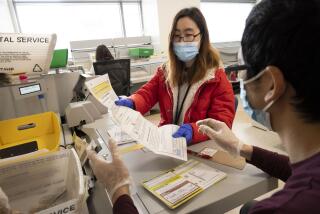‘Votomatic’ Still Holds Lead Among Vote-Counting Systems
- Share via
Computerized vote counting has its roots in California.
In 1962, Joseph P. Harris, a political science professor at UC Berkeley, came up with the idea of placing a standard IBM card in a ballot holder that displayed the candidates and issues, punching holes in the card to indicate voter choices and then counting these votes by running them through a computer.
The result was “Votomatic,” still the most widely used electronic vote-counting system in the nation.
In 1968, Harris sold his idea to IBM, but after a few years and many mishaps the giant computer company decided that the small profits to be made from selling vote-tabulation systems were not worth the enormous potential for bad publicity.
In 1969, IBM licensed five companies around the country to sell Votomatic. The most successful was Computer Election Services of Berkeley, which sold hundreds of the tabulation systems, mostly in the West, in the next few years.
One disadvantage of Votomatic is that names of candidates and ballot issues do not appear next to the rectangular holes to be punched out on the same computer card.
In another system, “Datavote,” the candidates and issues do appear next to the holes to be punched. To make this possible, however, several cards must be provided for each voter, which increases the cost of the system and adds to delays in counting ballots.
In California, Votomatic punch-card ballots are used by almost 65% of the voters, Datavote by 21%.
Another 12% vote with “mark sense” devices, which require the voter to make his choices by marking the ballot with a soft pencil or felt pen. The cards then are read by optical scanners similar to those used to grade school tests, before going to the computer.
These three computerized systems account for about 97% of the California vote and more than 50% nationwide. The remaining 3% of the state’s registered voters use lever machines, most of which are in San Mateo County.
VOTE-COUNTING SYSTEM Here’s a comparison of the methods used to vote in the 1988 presidential election, broken down into percentages of registered voters and counties.
* Voters mostly in New England, Michigan, Minnesota and Wisconsin, where voting is by townships, not counties; includes paper ballots and punch card systems.
SOURCE: Election Data Services
More to Read
Get the L.A. Times Politics newsletter
Deeply reported insights into legislation, politics and policy from Sacramento, Washington and beyond. In your inbox twice per week.
You may occasionally receive promotional content from the Los Angeles Times.










